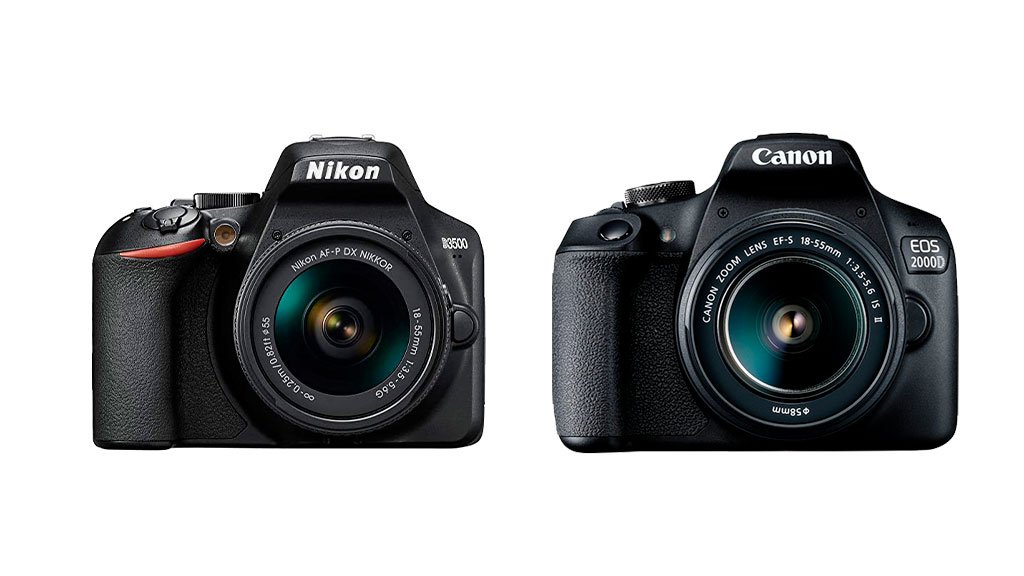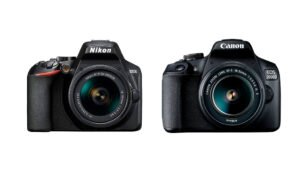The Canon 2000D and Nikon D3500 are two digital cameras that were unveiled to the public in 2018, they are DSLR (Digital Single Lens Reflex) cameras that are equipped with an APS-C frame sensor, with a resolution of 24 megapixels. With a high quality in both photo and video and a good quality resolution.
Nikon D3500 vs. Canon 2000D specifications
As always we will compare, the Nikon D3500 against the Canon 2000D. In this case we will comment on the key sections.
Nikon D3500 | Canon 2000D | |
SENSOR | 24 mpx APS C CMOS | 22.3 x 14.9 mm APS-C CMOS with 24.1 mpx resolution |
PROCESSOR | Nikon EXPEED | DIGIC 4+ |
FOCUS (AF) | 11 points | 9 points |
VIEWER | SLR viewfinder with 95% coverage | Canon EF viewfinder |
DISPLAY | 921000 LCD | LCD (TFT) of approx. 920,000 px |
ISO | 100 a 25600 | 100 a 12800 |
SHOTS PER SECOND | 5 fps | 3 fps |
MAXIMUM RAPIDITY | 5 fps maximum | 3 fps |
DYNAMIC RANGE | HDR high dynamic range | High dynamic range |
VIDEO RESOLUTION | Full HD at 60p
| Full HD at 30 fps
|
CONNECTIVITY | USB 3.1, Wi-Fi, Bluetooth 4.1 and NFC
| NFC, Wifi, Bluetooth |
BATTERY | EN-EL 14a
| Lithium Ion LP-E10. Approx. 500 shots
|
MONTURA | Type F | Canon EF-S |
WEIGHT | Approx 415 g | 475 g |
Features
These two cameras have a high resolution sensor, in this case the Nikon D3500 has a larger sensor, plays with the advantage that it is a recent model and its sensor benefits from technological advances, while the Canon 2000D has a native sensitivity range of ISO 100 to 6400, which can be extended to 12800. Many modern cameras are not only capable of taking still images, but also of capturing video images. They have sensors whose readout speed is fast enough to capture moving images, but the D3500 provides a faster frame rate than the 2000D, is capable of recording movie images at 1080/60p, while Canon is limited to 1080/30p. The 2000D and D3500 are similar in that they both have an optical viewfinder, the latter is useful for getting a clear image for framing even in bright environments, the viewfinders of both cameras offer the same field of view (95%), but the D3500’s viewfinder has a higher magnification than the 2000D’s (0.57x vs 0.50x), so the size of the transmitted image appears closer to the size seen with the naked eye. As for image data storage, both the 2000D and D3500 write their files to SDXC cards. The D3500 supports UHS-I cards (ultra high-speed data transfer up to 104 MB/s), while the 2000D cannot take advantage of ultra high-speed SD cards and that the 2000D offers wifi support, while the D3500 does not.
Sensor
Both cameras under consideration have an APS-C sensor, but their sensors differ slightly in size. The sensor area on the D3500 is larger, as a result of these sensor size differences, even though the D3500 has a larger sensor, both cameras offer the same 24 megapixel resolution. This means that the D3500 has a lower pixel density and larger individual pixels, giving it a potential advantage in terms of light gathering capability. The Nikon D3500 is a somewhat newer model and so its sensor could have benefited from technological advances during this time, we also mention that the D3500 does not have the anti-aliasing filter installed, so it can capture the details resolved by its sensor. Many modern cameras are not only capable of taking still images, but also of capturing video images. Both cameras under consideration have sensors whose readout speed is fast enough to capture moving images and the D3500 provides a faster frame rate than the 2000D.
Body
The Nikon D3500 is noticeably smaller than the Canon 2000D. In addition, the D3500 is noticeably lighter than the 2000D, since both cameras are based with an APS-C sensor, their respective lenses tend to have similar dimensions and weight.
Approach
SLR cameras usually have two different focusing systems, for photography we usually use the phase detection focusing system, based on a specialized detector, for video or photography we use the Live View mode. Both cameras include a phase detection focus system with independent sensor, in SLR cameras this phase detection sensor includes a series of specialized photosensitive element points, both have the fast and accurate system, although the Canon 2000D has a number of phase detection focus points of 9 points, while the Nikon D3500 has 11 points.
Video
As for video, neither records in 4K resolution, although it does record in Full HD, Canon 2000D can record up to 30 fps in this resolution, while Nikon D3500 in 60 fps. None of them has an external microphone input connector, you would have to use a microphone with an external recorder or auxiliary audio equipment to have better audio quality. In this case, the Canon does not have any continuous focus tracking in Live View mode, while the Nikon does and it is based on contrast detection focusing, including face detection and object tracking systems, being very independent of the situation, although they usually require a background with very little texture and that contrasts well with the subject.
Opinion
Each one is strong in a range of quality, Canon, usually has higher prices but is stronger in the high end, Nikon for its part is usually better positioned in the beginner and mid-range cameras, therefore, if you prefer to buy a cheaper model although the lower range, it is better a Nikon, as in this case the Nikon D3500, but if the professional can invest more high-end Canon are usually better. In terms of value for money, the Nikon D35500 offers everything a professional wants to have in their hands.







